How an Unsuspecting Collector Came To Believe a Found Cache of Previously
Unknown Watercolors Were Painted by the Great American Artist
When the contents of multiple New England estate liquidations were shipped
south for sale, a North Florida collector, over the course of five days, happened
upon seven framed sheets of unsigned late 19th-Century American watercolors. Here
is his story:
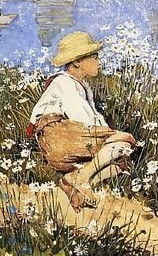
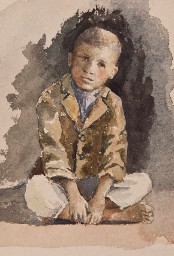
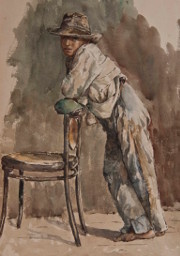
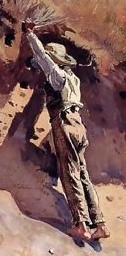
I was impressed initially by their from-life quality and gradually realized they possessed many
essential features and mannerisms characteristic of the hand of Winslow Homer.
To see why, consider the group of four watercolor drawings above: two works are
acknowledged as prime Winslow Homers, and two are selected from the found cache.
Each subject is barefoot, and the two on the right are wearing almost identical
clothing. The well-tempered palette is certifiably Homer's – the two found
works executed in studio light while the two known works are achieved en plein air.
Two of the found sheets have work on the reverse (a sign they likely were never intended for
exhibition), and four sheets bear pencil notations. "Jan 1 / '81" is the most
relevant, being a pivotal date in the artist's career – hallmarking the final watercolor
of his first great watercolor period and prelude to his fresh start. Homer
sailed for England on the Ides of March, 1881.
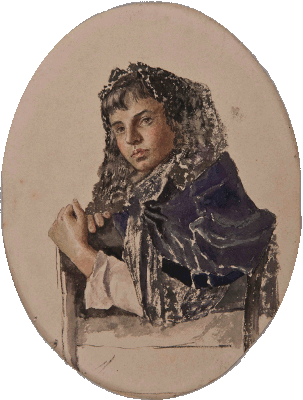
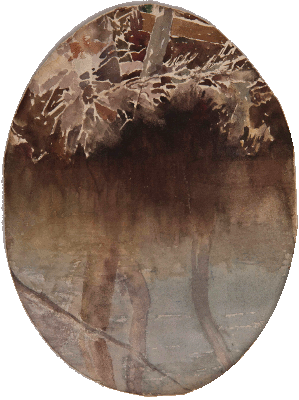
The found cache comprises nine works: (dimensions are in inches)
| Sitting Boy | 5.25x5.5 | A portrait of a boy sitting cross-legged on the floor, quite possibly the artist's eldest nephew Arthur Patch Homer (bears penciled "Sept 1" on reverse) |
| Youth Leaning on Chair | 11x15 | A figure study of a Huck Finn-like youth leaning against a studio chair |
| Fan-shaped Landscape | 15x11 | A fan-shaped landscape with figures and cows, on reverse of above |
| Young Woman with Mantilla | 7x9 | A detailed portrait of a young woman draped in a black lace mantilla. She is probably Gloucester-Portuguese and is arguably Homer's historically-elusive "Mystery Woman" |
| Shoreline Reflection | 7x9 | On the reverse of the above, a water study with reflections |
| Unadorned Young Woman | 4x4.5 | One of a pair of portraits of young women (sisters?), one of whom looks to be the young woman wearing the mantilla (penciled "Ava" [??] lower right) |
| Young Woman with Garnet Earrings | 4x4.5 | One of a pair of portraits of young women (sisters?), one of whom looks to be the young woman wearing the mantilla (penciled "Carmen" lower right) |
| Mask with Books | 6x8 | A rare still-life featuring a classical mask propped against stacked books |
| Mannequin | 10x14 | An intentionally enigmatic study of a one-legged mannequin (this one bears the penciled "Jan 1 / '81" notation) |
How do we determine authenticity of Homer's authorship?
In this case, there are three elements that come into play:
In this case, there are three elements that come into play:
- Facture: the known way or manner that an artist creates a work of art. This is determined by careful study and comparison to the known catalogue and canon by an enlightened individual or group. These works adhere to that standard.
- Proof of facture: scientifically confirmable evidence via state of the art forensic examination and high-resolution photography. These works have passed such examinations of their materials: paper, pigment, graphite, etc.
- Provenance (the only variable here): the known history of a work of art
from the time it leaves the artist's hands to the time of its acknowledgement
as part of an artist's record of works, his catalogue raisonnée.
(Omission from a catalogue
raisonnée means a work is disputed - or, in the worst case, is
considered a forgery.) During the period 1878-1880, in preparation for his sojourn
to England, Homer disposed of
hundreds of works on paper: studies, sketches, drawings, and a few
minor oils. The vast majority of these publically-auctioned works were never
recorded, few had been exhibited, and who knows how many were not signed. We
know that Homer's signature was never a prerequisite for
completion, exhibition, or sale. Unsigned Homer watercolors, some quite famous,
are well documented: Gordon Henricks's 1979 catalogue of Homer works in
public collections lists 22, and the new Homer Record of Works
(catalogue raisonné) lists over a dozen more. Such recognition validates
the belief that Winslow Homer's distinctive watercolor brush is
self-declarative – a signature in
and of itself.
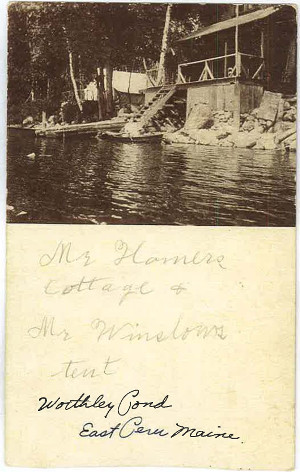
Given that many of Homer's earlier works lack watertight provenance, it is fortunate in this case to have an obvious association with Homer or the Homer family. I also retrieved from the same source as the seven framed sheets a group of amateur photographic postalcards postmarked Maine, 1907, with annotations: - "Mr & Mrs Homer, out boating" (Worthley Pond, E. Peru, Maine)
- "Mr Homers cottage & Mr Winslows tent" [sic]
- Others have references to the "Savage" and "Libby" families. Both Winslow's father and older brother were named Charles Savage Homer, and today's "Prout's Neck" was previously known as "Libby's Neck." Homer was acquainted with and employed at least two members of the Libby family.
The Winslow Homer Record of Works preface
states, "A catalogue raisonné is never finished – no matter how many
years have been devoted to the search for an artist's every surviving work, it is
always possible that something new will be revealed." Given the found works' inimitable
facture, their remarkable original period vibrancy,
and the intriguing association provenance, it is strange that leading members of
the Homer Record/catalog raisonné who were
contacted were unwilling to invest time in research, and all were tentative about
making definitive judgments. From photographs provided, the Director stated,
"It is my opinion ... that none of these watercolors shows a relationship to the acknowledged work of
Winslow Homer either in sylistic characteristics or quality of
execution. They seem likely to have been the work of a fairly advanced student..."
One senior licensee of the catalogue simply precluded, "We have already
seen everything by the artist" and "The Homer catalogue is closed," remarks which are
clearly at odds with the preface of the catalogue. I feel their responses
did not meet an important standard in the art world:
| Artnet News, February 1, 2013, "Art Law on Protection for Art Experts" |
| "Where the expert is giving a private opinion, that is, one not published for the public ... in order to receive First Amdendment protections for their opinions, experts should make a reasonably full recitation of the facts upon which their opinion is based." |
Clearly, the authenticity of these works has never been seriously considered, let
alone disproven. In the face of compelling evidence of their authorship,
the leading "authorities", those with the power to validate or deny, refused to give
them serious consideration. Their reasons are not apparent. That turning
away leaves their value, both monetary, and that of becoming a part of the accepted legacy of the great Winslow Homer,
in an ambiguous and untenable state.
What makes a work of art valuable?
"Value" exists on a continuum between objective and subjective.
"Value" exists on a continuum between objective and subjective.
Objective value lies in the collective judgment of an artistic community and relies
first, on the reputation of the artist, and second, the closely related demand for
their work. Art is inherently a limited resource, with the consequence that demand
can drive the price of the work - as an object. Much effort is expended in
the commercial art marketplace to determine whether a work has properties which
enhance its objective value, the prime one being whether it is actually the work of
the artist in question.
At the other end of the spectrum is subjective value. A widely-shared personal
appreciation of a work is a factor in the kind of objective valuation discussed
above. But any given individual will have a personal, subjective response to any
given work, regardless of whether it is seen
to be "authentic" or appealing to the arbiters of objective value.
It's also possible for someone to perceive value in a work which they believe to have
been overlooked; this would be true, for instance, of someone who obtains a work which has not yet been recognized
as having been produced by an objectively-valuable artist.
Have we really seen everything by Winslow Homer?
I have good reason to believe that some small number of still-unrecognized Homer works
exist, their provenance lost, awaiting recovery and validation. Will they all meet
the same dismissive fate by the
arbiters of value: given no fair evaluation, rejected out of hand?
How do those arbiters imagine Winslow Homer would view their actions? One wonders.
The majority of works Homer produced were created to generate income. That does not
imply they had no personal meaning for him. Winslow Homer's stature emanates from putting
himself into every work, every study, no matter how slight. To Winslow Homer his art
was an all or nothing proposition. As a result, these found works have an elegance and refinement that belies one's
first impression of them, revealing itself though continued viewing. It was Homer's
pleasure to reward the observant viewer.
In short, I believe this discovery affirms Winslow Homer's reported prescient
end-of-life lament, his warning that any attempt to catalogue his life's work
would most likely fall short of his complete approval. These unsigned "private
studies" were never meant for sale or exhibition and were most likely gifted to a
certain individual. The connection
to Homer and their significance were lost and have remained so through several
generations, to this day. Only a twist of fate – combined with my experience and
intuition – has brought them to light. Do they now, a hundred
and ten years after the artist's death, ironically fulfill a revenant Winslow
Homer's declaration: his prophecy, "You will see, in the future, I shall live by
my watercolors."
Questions or comments? All inquiries are welcome -
click
here to contact the finder.
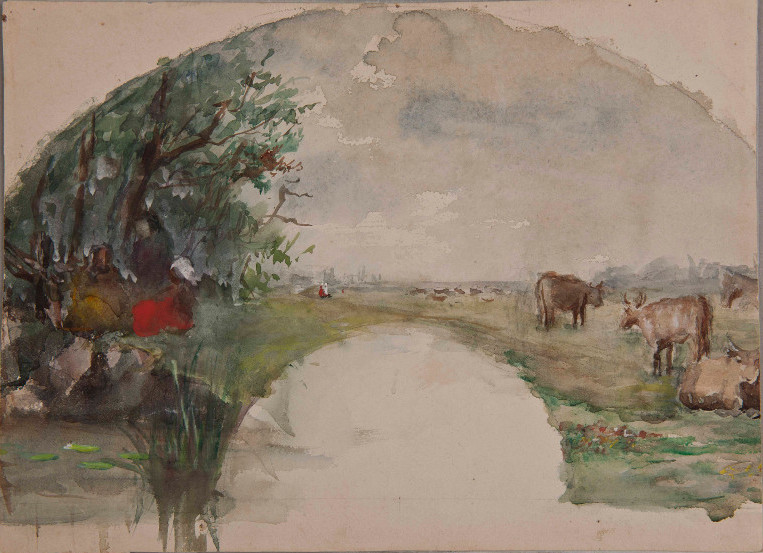
Read the collector's detailed Notes and
Observations for each found work =>